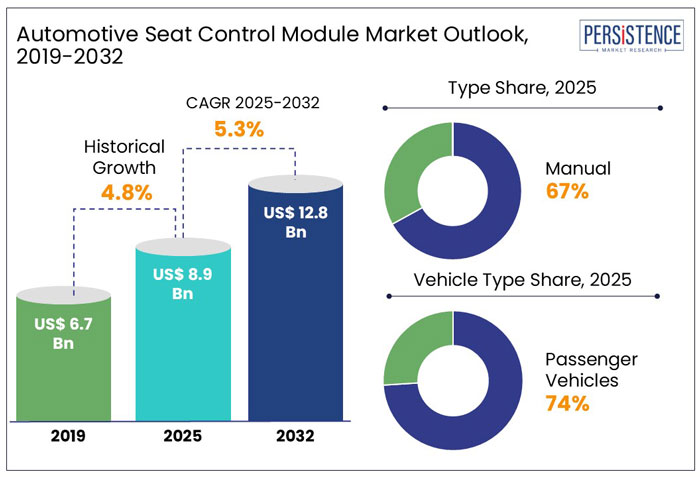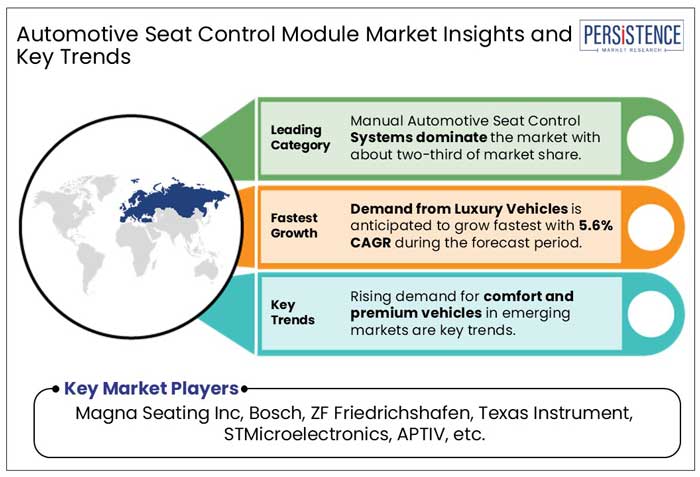Industry: Automotive & Transportation
Published Date: March-2025
Format: PPT*, PDF, EXCEL
Delivery Timelines: Contact Sales
Number of Pages: 245
Report ID: PMRREP14929
The global automotive seat control module market size reached US$ 8.5 Bn at the end of 2024. Worldwide automotive seat control module sales are anticipated to increase at a CAGR of 5.3% between 2025 and 2032 to reach around than US$ 12.8 Bn by the end of forecast year.
More than 70% of the global market for automotive seat control modules is collectively accounted for by manual seat control module types. The market is anticipated to develop over the course of the forecast period as a result of the rising demand for comfortable and relaxed seating.
Revenue from the sales of automotive seat control modules currently accounts for a 3.2% share of the global automotive electronics market.

| Report Attribute | Details |
|---|---|
|
Market Size (2019A) |
US$ 6.7 Bn |
|
Estimated Market Size (2025E) |
US$ 8.9 Bn |
|
Projected Market Value (2032F) |
US$ 12.8 Bn |
|
Value CAGR (2025-2032) |
5.3% |
|
Collective Share: Top 3 Countries(2025) |
48.1% |
Automotive seat control module sales have been consistent over the past five years as a result of rising consumer demand for comfort, safety, and aesthetics in vehicles. OEMs are concentrating on adding the most automation possible to vehicles so that comfort and safety can coexist. Countries with the fastest growth in this industry are the United States, China, and Japan.
By volume, demand for automotive seat control modules is projected to increase at 4.9% CAGR in the first half of the forecast period and 4.2% in the second half, owing to various features being incorporated in seat control modules such as seat heating and air conditioning, seat position adjustment, massage function, and headrest positioning.
Memory seat control module usage is anticipated to increase at a volume CAGR of 5.6% over the decade. These advanced memory modules save and regulate the user's seat settings. They offer the user heating, ventilation, and cooling options in addition to seat and mirror adjustments. Memory seat control modules are expected to experience increasing demand over the coming years in light of these cutting-edge comfortable features for commuting.
Demand for passenger vehicles is expected to increase as a result of growing urbanization and infrastructure development. The passenger vehicles segment retained a high market share of around 73.8% by volume in 2024 as a result of expanding transportation infrastructure and rising disposable income. However, the deployment of automotive seat control modules, especially power seat modules, in commercial vehicles is anticipated to increase at a volume CAGR of 5.4% through 2032.
“High Demand for Relaxed & Comfortable Seating”
Customer attitudes toward safety and comfort are evolving frequently. Long-distance traveling calls for comfort and the development of modern automobile seats has made it possible to facilitate a comfortable driving experience.
Such integrated systems that regulate seat functions are cost-effective and significantly enhance vehicle performance. The preference of consumers for high-end vehicles is growing as a result of integrated technology in automotive body components. The preference for automobiles with comfortable seating characteristics is rising as a result of increasing customization for end users leading to a more comfortable driving experience.
“Rising Popularity of Premium Vehicles in Emerging Countries”
The luxury cars segment is rising as a result of the continued increase of ultra-high-net-worth individuals. High demand for high-value automobiles has attracted new market entrants, especially in China, resulting in a rising number of new product launches, such as memory seat ECUs.
The luxury cars segment is expected to observe heightened competition with the entry and expansion of new market players, which will help expand market size, giving consumers more options to choose from.
Currently, East Asia holds the highest share of the global automotive seat control module market; however, the South Asia Pacific regional market is projected to expand rapidly at a volume CAGR of 6.5%. Along with East Asia, the market in North America is also projected to rise steadily at a CAGR of 5.5% through 2032.
Why are Automotive Seat Control Module Producers Eyeing the Asia Pacific Market?
“Growing Transportation Infrastructure Development in Asia Pacific”
Consumption patterns vary by area and are seen to be robust in developing nations such as China and India. Demand for body electronics components such as seat control modules is increasing as consumer preferences for convenient and comfortable travel experiences change.
The market for seat control modules is being further bolstered by rising capital investments in the automobile sector and transportation infrastructure. The market for automotive seat control modules is anticipated to rise in response to factors such as rapid urbanization and swiftly expanding economies brought on by significant investments in infrastructure development.
A combination of favorable government and infrastructure expenditures is predicted to drive the significant expansion of transportation infrastructure throughout the Asia Pacific region. Rising disposable income in Asia also contributes to the region's high growth potential for suppliers of automobile seat control modules, which, in turn, drives regional demand growth.
Throughout the projection period, it is anticipated that the market for automotive seat control modules in East Asia would rise at a value CAGR of 5.1%. The Asia Pacific region is expected to continue to hold a sizable share of more than one-third of the global market for automotive seat control modules due to the region's increasing urbanization and infrastructure development.
Which Countries Account for High Demand for Automotive Seat Control Modules in Europe?
“European Market Growth Led by Germany & France”
With around 28% of the global market share, Europe is predicted to be the second-most prominent market for automotive seat control modules. The market in Germany is expected to expand at a value CAGR of 3.8% during the forecast period and is a significant contributor to the European market.
Germany is Europe's prominent contributor, followed by France; these countries are likely to drive high demand for seat control modules in the automotive industry of the European market.
The France automotive seat control module market is estimated to have more than 14% of the European market share during the projection period. The country's rising passenger vehicle production is one of the main factors fueling market growth.
Which Type of Automotive Seat Control Module is Expected to Exhibit High Demand Growth?
“High Demand Predicted for Manual Automotive Control Modules”
The popular type of seat control module in cars – the manual seat control module - is anticipated to hold 67% value share of the global market in 2025.
Demand for manual vehicle control modules is being driven by the variety of seat positions, scalable controls, and climate-controlled seat functionalities that these manual seat control devices offer.
However, it is anticipated that by 2032, the market for memory seat control modules would be valued at US$ 5.1 Bn, expanding at a CAGR of 5.9% over the decade. Memory seat control modules have the added benefit of offering more adjustment options to store user settings according to their desire.
Which Type of Passenger Vehicles Will Account for High Market Expansion?
“SUVs & Luxury Vehicles to drive Major Demand in the Market”
Automotive seat control module deployment in premium vehicles such as SUVs and luxury vehicles is estimated to increase at 4.3% and 5.6% CAGRs, respectively, to reach a market valuation of around US$ 4.44 Bn by 2032.
Customers are drawn to luxury cars because of their elegant design, luxurious interiors, and the exceptional experience they provide. Manufacturers want to differentiate their products by improving the travel experience and interior design. Around 38% of the passenger cars segment's share is made up of SUVs.
Automotive seat control modules are anticipated to become more common in the mid-size car class, which now accounts for around one-third of the total passenger vehicles market. During the forecast period, it is expected that the demand for commercial vehicles will increase at a volume CAGR of 5.4%.

The market for automotive seat control modules has experienced an increase in new product development and market expansion efforts over the past few years. Automotive seat control module manufacturers are concentrating on creating integrated seat control modules with more functionalities, such as massaging features and temperature-controlled heating and cooling for the seats.
|
Attribute |
Details |
|---|---|
| Forecast Period |
2025-2032 |
|
Historical Data Available for |
2019-2024 |
| Market Analysis Units | Value: US$ Bn/Mn, Volume: As applicable |
|
Key Countries Covered |
|
|
Key Market Segments Covered |
|
|
Key Companies Profiled |
|
| Report Highlights |
|
|
Customization & Pricing |
Available upon Request |
Automotive Seat Control Module Market by Type:
Automotive Seat Control Module Market by Application:
Automotive Seat Control Module Market by Vehicle Type:
Automotive Seat Control Module Market by Region:
To know more about delivery timeline for this report Contact Sales

The global automotive seat control module market reached a size of US$ 8,555.6 Mn at the end of 2021.
Sales of automotive seat control modules are projected to increase at 5.3% CAGR and top US$ 15 Bn by 2032.
Increasing consumer preference for seat heating and ventilation is majorly driving market expansion.
China, the U.S., Germany, India, and Japan are lucrative markets for automotive seat control module suppliers, with Europe projected to hold the highest market share of around 26%.
Passenger vehicles will generate more demand for seat control modules and the segment is projected to expand at a volume CAGR of 4.8% over the forecast period.
Continental AG, Infineon Technologies AG, Hyundai Mobis Co., Ltd., HELLA GmbH & Co. KGaA, and Lear Corp. are prominent manufacturers of automotive seat control modules, accounting for over one-third market share.
The market for automotive seat control modules in North America is predicted to expand at 5.2% CAGR through 2032.